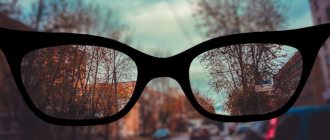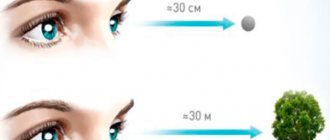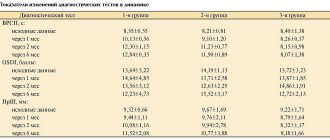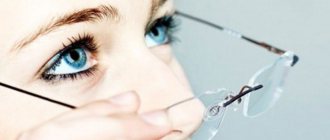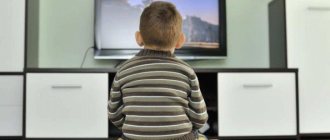The question of whether it is possible to restore a child’s vision worries many parents. To understand this, you should have an understanding of diseases of the visual organs.
The most common ailments of the visual system are:
- Spasm of accommodation, called false myopia. This disease occurs as a result of spasm of the eye muscles caused by excessive fatigue of the visual system. To eliminate the disease, it is enough to give your eyes a rest and relaxation. If preventive measures are not taken, the disease can develop into myopia;
- Myopia (nearsightedness). This disease is characterized by the fact that a person cannot focus his gaze on objects located in the distance. The disease has three stages. It is possible to suspend it at the first stage;
- Hypermetropia (farsightedness). It is less common in school-age children and adolescents. A person has difficulty seeing objects located nearby;
- Astigmatism. The image appears blurry because the rays passing through the cornea are refracted differently. This disease is usually accompanied by myopia or hypermetropia;
- Amblyopia (lazy eye syndrome). A disease in which one eye partially or completely does not work. If measures are not taken in time, the defective eye may stop seeing altogether.
Common vision diseases in children
Before the age of 12, farsightedness and nearsightedness are common diseases. Pathologies develop against the background of imperfections of the visual apparatus or weakness of the visual organs. Provoke eye diseases in children:
- spending long periods of time in front of a computer monitor;
- hereditary predisposition;
- unbalanced diet;
- visual fatigue;
- failure to comply with personal hygiene rules.
Diseases of the visual system lead to related problems:
- restrictions on sports;
- rapid fatigue when playing with small particles;
- severe visual strain due to refractive errors.
Causes and signs of myopia in a teenager
Myopia is often inherited, especially in families where both parents are myopic. The disease does not appear immediately: at first, all children are farsighted by nature. However, by the age of 8-9, as the eyeball develops, farsightedness disappears. The exception is children with hereditary (congenital) myopia, in whom in adolescence it reaches high levels and attracts the attention of parents.
In a child whose parents do not suffer from myopia, the risk of developing myopia reaches 25% (usually the risk is promoted by improper visual hygiene or organization of the workplace, an unbalanced diet or increased visual stress). Children whose parents have myopia have a 50% or more risk of developing the disease2.
It should be taken into account that school-age children tend to hide vision problems, because... they don’t want to be “bespectacled.” Therefore, in most cases, identifying myopia falls entirely on the shoulders of the parents.
The following symptoms, noticeable when observed from the outside, will help to identify diseases in a timely manner:
- when trying to see something in the distance, the teenager squints and may even show irritation;
- a teenager often rubs his eyes, especially in the evening, as well as while reading, doing homework, or playing on the computer;
- the eyes often look red, with a pronounced network of blood vessels;
- a teenager gets angry at jokes about how he should have a diamond eye at his age.
Treatment methods
To eliminate pathologies of the visual apparatus, various techniques are used:
Physiotherapy
Physiotherapy techniques are used for diseases of the visual apparatus:
- astigmatism;
- amblyopia;
- strabismus;
- glaucoma;
- farsightedness.
The decision on the need and duration of a course of physiotherapy is determined by the attending physician. Physiotherapeutic procedures include:
- electrical stimulation;
- color therapy;
- ophthalmochromotherapy;
- laser stimulation;
- magnetic therapy;
- video-computer correction of the level of visual function.
It is possible to prescribe physiotherapeutic procedures for the purpose of prevention and elimination of diseases in the early stages of development.
Operation
Surgery is not recommended for children under 18 years of age, as it is difficult to predict the outcome of the operation.
Eye exercises
To strengthen the muscle fibers of the visual apparatus, the following exercises are recommended:
- Step gymnastics. To perform the exercise, you need to move 1 meter away from the window. Extend your hand forward, palm up. Try to examine the pattern on the surface of the skin. After 10 seconds of looking, the gaze is transferred to the window frame. Then the gaze is transferred to 50 meters or 100 meters outside the window. At the end of the exercise, the gaze is transferred to the clouds. To complete visual gymnastics, you need to gradually move your gaze back to your palm. It is also advisable to perform the movement during periods of prolonged stress on the visual organs. Gymnastics is allowed for children aged 5 years and older.
- Gymnastics with numbers. Initially, you need to rub your hands together. Covering your eyes with your palms, begin to draw numbers from 1 to 10 and back with your eyes. When performing the exercise, it is advisable to try to move your eyes to the sides as much as possible. Movement is recommended for school-age children to relieve strain on the visual system.
- Acupressure exercises. The complex is designed to improve blood circulation and improve the quality and clarity of the perceived image. On an A4 sheet of paper, draw 10 dots, preferably black. The recommended gap between them is about 5 mm. The parent takes the paper and places it 40 cm from the child’s visual organs. The sheet must be removed by 20 cm. If the picture is blurry, it is necessary to write down the distance and not exceed it at first. It is recommended to perform for 5 minutes about 4 times a day. To identify achievements, you must check the maximum distance every 10 days.
- Arc. Exercise relieves fatigue, increases the clarity of the perceived image, and eliminates spasm of accommodation. Before the exercise, you need to sit on a chair in front of the window. You need to draw a rainbow with your gaze, starting from the knees. You can stop your gaze on all interesting objects for no more than 5 seconds. The movement is performed by repeating 3 times. To relax the muscle fibers, alternately closing and opening the eyelids is recommended. For regular, long-term exercise, it is advisable to perform the exercise several times during the day.
At the initial stage, it is recommended that parents perform gymnastic exercises together with their children. It is also advisable to control the correct execution and size of repetitions of movements.
Massage
Massage of the visual apparatus is an additional technique for relaxing tired eyes and increasing their blood circulation. Massage procedures for the visual apparatus include:
- massaging the organs of vision with the palms;
- light pressing;
- vibrating exercises;
- stroking the eyelids.
When performing a massage, it is recommended to monitor the level of pressure, as injury to the eyes is possible due to carelessness. It is advisable to carry out massage procedures for children with the participation of parents, which will reduce the risk of injury.
How to restore a child's vision?
The eyes have a very complex structure. Depending on environmental factors, vision may improve or deteriorate. In order to restore vision at home, you first need to understand the reasons for its deterioration and contact an ophthalmologist for advice.
There are several general concepts that will help both prevent further deterioration of vision and improve it.
Firstly, it is necessary to regularly do special exercises for the eyes to enrich them with blood and so that they rest after prolonged stress.
Secondly, give your eyes proper rest, including proper sleep.
Thirdly, do not let your eyes become overstrained; you should not sit at a computer, TV, or tablet for a long time.
Fourth, adjust your diet so that your eyes receive all the necessary beneficial elements.
Fifthly, follow the recommendations of the ophthalmologist to improve vision specifically for your child and, if necessary, use additional means prescribed by the doctor.
Useful video
A child’s vision can be completely restored with properly designed therapy, which includes all restoration techniques, since only complex treatment can guarantee results.
Author's rating
Author of the article
Alexandrova O.M.
Articles written
2029
about the author
Was the article helpful?
Rate the material on a five-point scale!
If you have any questions or want to share your opinion or experience, write a comment below.
Hardware treatment
Hardware techniques include the use of:
- physiotherapy (laser, infrared and magnetic radiation),
- computer programs,
Restoring vision in children using hardware techniques is used as an independent method of treatment. At an early age, the formation of interaction processes between the nervous system and the eyes occurs. Hardware treatment allows you to optimize these processes, improve the perception and processing of images by brain cells.
In adults, hardware methods are used in the complex treatment of myopia. In this case, the goal is:
- relieving spasm of accommodation,
- improvement of blood circulation in the structures of the eyeball (primarily in the retina),
- improving the functioning of the nervous system.
Hardware treatment does not correct disturbances in the refractive media of the eye, which cause improper focusing of the image on the retina. Therefore, for adults, a justified solution may be a microsurgical operation - laser vision correction for myopia.
How to restore vision at home
It is necessary to understand that when visual function declines, every effort must be made to restore lost vision to your child. If absolutely nothing is done, then only worsening myopia will be observed, and this is very dangerous and sometimes even leads to partial or irreversible blindness. Naturally, you need to follow all the doctor’s instructions, but in addition to them, you can and should use special techniques and a lot of other methods that help normalize not only the condition of the eyes, but also improve the overall health of the child.
- It is impossible to restore vision and improve its performance in a child unless you explain to him the harm from the computer and TV. Naturally, it will not be possible to completely abandon these multifunctional modern devices. But any child, already at the age of three or four, should understand that he can spend no more than one hour watching cartoons all day. It is advisable to divide this time into several times. First grade schoolchildren can spend no more than an hour playing video games and the same time watching television.
- It is necessary to reconsider nutrition. Children of the first years of life should receive mainly only healthy, natural and fresh products. Their diet should always include lactic acid products, fresh vegetables, any fruits, cereals, and meat. You can restore lost vision with the help of fresh berries. In the summer, it is advisable to give the child half a glass of currants, strawberries, blueberries, raspberries, blueberries, and lingonberries every day. Fresh carrots contain a lot of vitamin A, which is beneficial for the eyes, but you need to remember that this healing vitamin is absorbed by the digestive system only in tandem with fats. Therefore, your child can prepare grated carrots seasoned with a spoonful of sour cream; this addition to breakfast has a positive effect not only on visual function, but also enhances growth. Potassium is also good for the eyes; it is found in large percentages in dried apricots. If there is no allergy to honey, children should definitely be given this tasty and healthy beekeeping product; it will not only help restore vision, but will also have a beneficial effect on the nervous system and strengthen the immune system.
- Some sports help strengthen the eye muscles. It is necessary to select sports sections where children are forced to monitor a constantly moving object, this allows them to train the eye muscles. An example of such sections would be table tennis and football. Swimming strengthens the general condition of the body.
- You won’t be able to restore your vision unless you revise your daily routine. Children should definitely spend part of the day outside, playing outdoor games and simply absorbing oxygen that is beneficial to the body. The whole day should be planned in such a way that there is room for the necessary activities, games, and rest. In the summer, it is advisable to think carefully about the child’s leisure time - you can send him to a health or sports camp, take him to relatives in the village for fresh, unpolluted air and natural food.
In order for a school-age child’s vision to never deteriorate, it is necessary to accustom the student to the correct routine and to following the basic rules for completing lessons from the very first day of classes. If this is not done, then later problems will appear not only with the eyes, but also with the spine and other important systems of the body.
The correct daily routine for a schoolchild
So that parents do not have to think about how to restore their child’s vision, it is necessary to accustom the child to the correct approach to doing homework from the very first grade. The most important thing that parents should do is to organize the workplace of a first-grader as it should be. The child should have a table and chair suitable for his height, and the lighting should fall on the left side if he is right-handed or on the right if the baby uses his left hand to write. You can also use a table lamp as a light source. Visual hygiene must be observed; it includes:
- Do your homework in no more than 30 minutes. After this, the student should rest for 15-20 minutes, but this does not mean that he is simply obliged to watch cartoons or play on the phone during this time. During your vacation, you can do physical exercise, have lunch, and play with construction sets. But if the child’s vision is already impaired, then it is worth doing eye exercises at this time.
- Limit watching TV and playing games on the computer to up to an hour.
- Proper reading of books. Children should hold a textbook or book at a distance of at least 30 cm from the eye area and it should be explained to them that they should never read in a lying position or in poor lighting.
If your vision is severely impaired during the period of its recovery, reading books can be replaced by listening to audio materials. Now, if necessary, you can easily find records of any stories, fairy tales, tales.
Gymnastics for the eyes
Ophthalmologists always recommend that their young patients with myopia perform special eye exercises every day. Exercises help relieve eye strain, train muscles, increase blood circulation and nutrition in the eyeball area. All this has a positive effect on visual function. There is no need to assume that eye exercises are necessary only for myopia; it also serves as a method of prevention, and therefore can be recommended for children of any age. Naturally, if certain abnormalities in the eyes are detected, the doctor will prescribe special exercises. Below is a set of eye gymnastics that can be used to eliminate minor myopia or to prevent it.
- It is necessary to teach the child to rotate his eyes clockwise and vice versa, to move the eyeball down and up. It is necessary to perform this exercise several times, but the baby’s head must remain motionless.
- The child should close his eyes tightly for a few seconds and then open them wide. You need to repeat this eye exercise 5-7 times.
- Look straight ahead, a hand moves forward with one extended finger, and the child needs to focus his gaze on the tip of this finger. After a few seconds, the hand is released and the exercise is repeated.
- It is necessary to alternately move your gaze to the lower left corner, then to the upper right, and vice versa. This movement helps coordinate the movement of the eye muscles.
- With your eyes closed, you need to massage them. The upper eyelid is massaged in a circular motion from the nose to the temples, the lower eyelid, respectively, from the temples to the nose.
It is recommended to repeat the proposed complex of eye gymnastics up to three times a day. These activities allow you to rest your eyes, strengthen the eye muscles, and improve blood circulation. Vision can be improved and strengthened with the help of other simple and fun exercises for children. Some of them are presented in poems, riddles; now, if desired, on the Internet you can find any healing methods for children that are easy to implement and highly effective.
Visual function is one of the most important and in demand throughout life. If you notice that your child begins to squint, bring a book closer to his eyes, or sit next to the TV screen, then you should not put off a visit to the doctor indefinitely. It is easiest to restore decreased vision before the age of 12; until about this age, almost any pathological changes can be reversed.
You can share the article with friends via social media. networks:
Ways to restore vision
The easiest way to restore vision is to use glasses or contact lenses. In some cases, eye training has a good effect. However, they will only be effective for small deviations that have arisen recently.
For myopia
With myopia, the eyes quickly get tired, as they are subject to heavy strain. Doctors often prescribe the use of special drops. To achieve maximum effect, they must be used together with other methods of complex treatment.
Effective drops:
- Emoxipin. The drug eliminates minor hemorrhages on the retina and strengthens it. As a result of this effect, the tissues of the eyeball are strengthened and blood circulation is activated. Drops help prevent oxygen starvation of tissues.
- Irifrin. The effect of the drops is that they prevent the mucous membranes from drying out. The drug can be used to increase intraocular pressure. Irifrin has a large number of contraindications. It should not be used to treat children under 12 years of age.
- Visine. The drug relieves puffiness from the eyes and has a local vasoconstrictor effect. The active components are practically not absorbed into the bloodstream.
- Zorro. The medicine is used as a dietary supplement. It contains B vitamins and herbal extracts. Drops moisturize the mucous membrane and activate metabolism.
The use of the drug should be under the supervision of a physician. He prescribes drops, indicates the dosage and calculates the duration of the therapeutic course.
To correct myopia, wearing contact lenses or glasses is prescribed. It is also recommended to perform simple eye exercises.
IMPORTANT. Surgical vision correction is prescribed for high degrees of myopia.
However, this procedure does not cure the disease; they compensate for vision due to changes in the upper layer of the cornea. The procedure itself lasts for several minutes and does not require long recovery.
For farsightedness
For the treatment and prevention of mild farsightedness, it is recommended to perform gymnastics. Its essence lies in alternate tension and relaxation of muscles.
Training according to the Bates system gives a good effect. It will help restore vision without surgery. Effective exercises:
- looking up and down
- diagonal eye movement
- drawing squares and circles with the eyes.
While doing eye exercises, you should try to sit straight. All exercises must be performed 4 times, at the end point the gaze must be fixed for 5 counts. To obtain the desired effect, gymnastics must be performed 3 times a day.
In addition to the prescription of glasses and lenses, vision restoration can be carried out using special devices. They help stop the progression of farsightedness. This treatment method is suitable for patients aged 3 years and older.
IMPORTANT. Color pulse therapy has a good effect.
The device, where the patient is looking, has built-in emitters that transmit light pulses with wavelengths of different lengths. As a result of this effect, the nerve endings are irritated and the centers of the brain are activated.
This method of vision restoration improves blood circulation and activates the lymphatic drainage system. This treatment method will be effective if used in combination with other methods.
Ultrasound stimulation, vacuum massage and electrocoagulation can be used to treat farsightedness.
Pharmacotherapy for adolescents
Pharmacological methods can alleviate the symptoms of conditions accompanying myopia, such as disturbances of accommodation and binocular vision. Evidence-based medicine does not have data on the effectiveness of these methods (with the exception of atropine drops) in slowing the progression of myopia.
For the drug treatment of myopia in adolescents, the following groups of drugs are mainly used as part of an integrated approach:
- drugs affecting ciliary muscles (accommodation) - anticholinergics, sympathomimetics;
- activators of collagen synthesis (help strengthen the sclera - the outer layer of the eye);
- trophic therapy drugs - stimulants of blood circulation and metabolic processes, drugs to normalize the function of cell membranes, vasodilators);
- drugs that improve retinal regeneration;
- vitamin and mineral complexes (especially with vitamins A, E, C, zinc, molybdenum).
Medicines for myopia in adolescents are used orally, in the form of eye drops, injections, and are also introduced into the eye tissue using hardware procedures - electrophoresis or phonophoresis (usually carried out with antispasmodic solutions to relax the eye muscles).
Courses of drug therapy are preferably carried out 2 times a year, however, the duration of courses and intervals between them can be changed at the discretion of the treating ophthalmologist.
Surgical treatment of adolescents
Surgical treatment of myopia – laser vision correction is not performed on patients under 18 years of age.
However, with rapidly progressing myopia (more than 1-1.5 diopters per year), certain types of surgical intervention may be prescribed. They are aimed at curbing the progression of the disease.
Most often, adolescents with diopters of 6.0 units or more undergo scleroplasty - an operation designed to strengthen the outer layer of the eye. During sclero-strengthening surgery, a special composition (components of the patient’s blood or a synthetic hypoallergenic gel) is usually injected into the posterior pole of the eye, which inhibits the myopic elongation of the eyeball and restores normal tissue trophism. There is another type of sclera-strengthening intervention, which involves suturing fragments of transplant material to the posterior pole of the eye. In the USA and Western European countries, such operations are not widely used.
Therefore, it is best to consult a doctor at the first symptoms of myopia, when it can be slowed down using methods, preferably filtered by evidence-based medicine.
